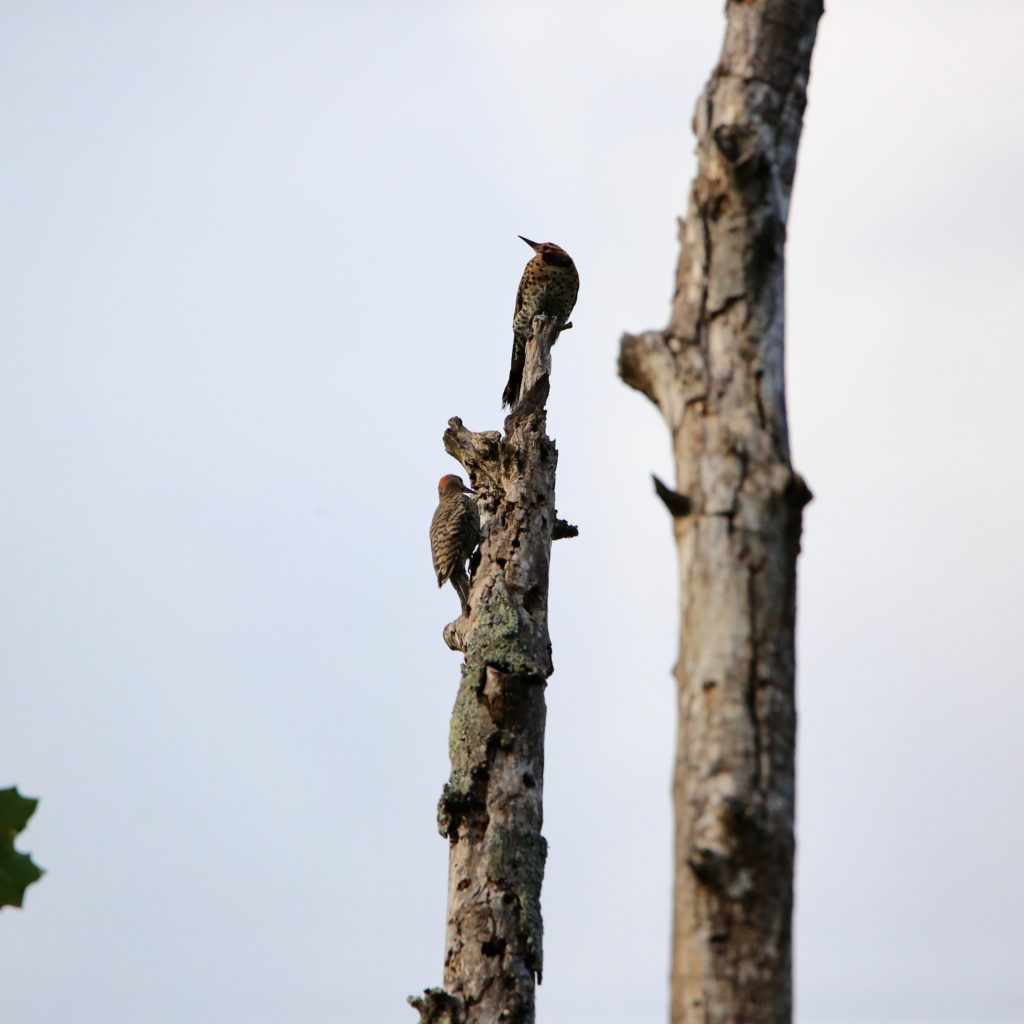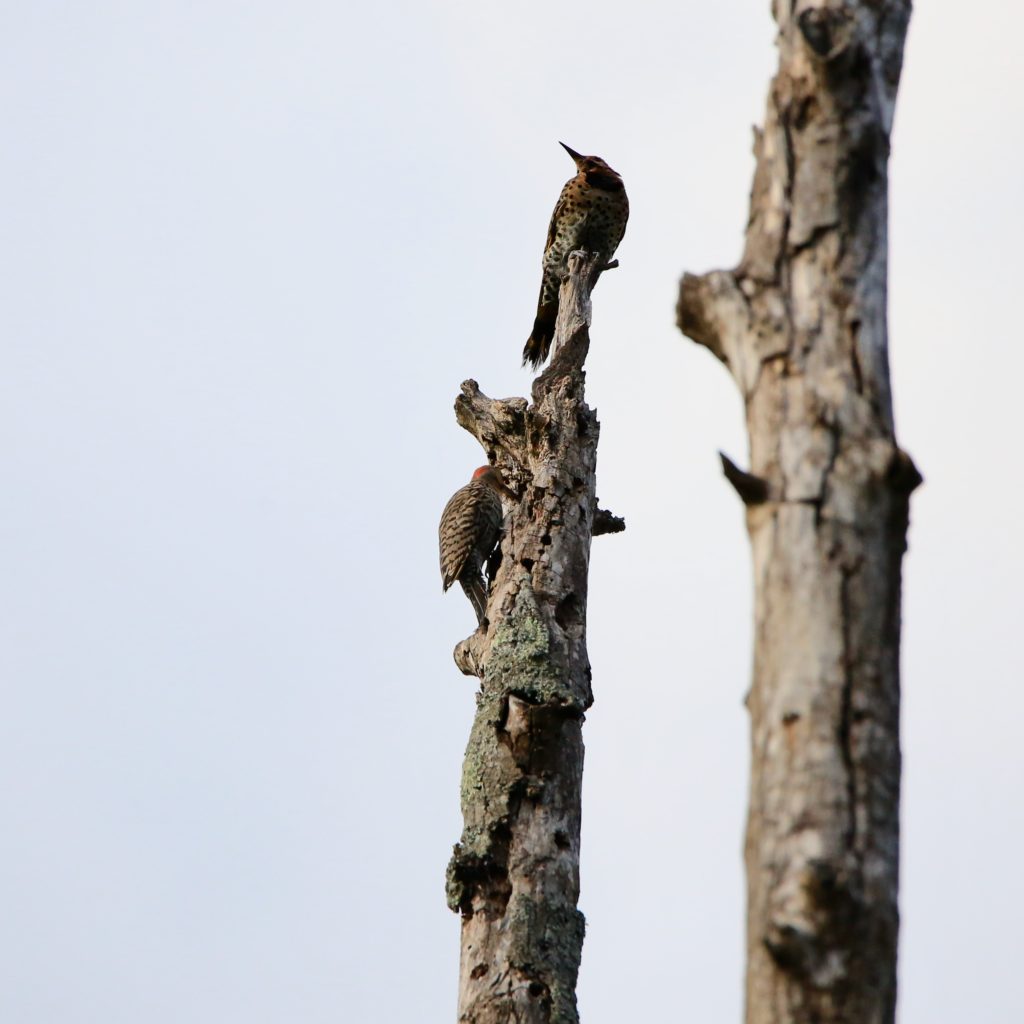
The Northern Flicker
A Northern Flicker is a fun bird to see while bird watching. Below are some tips to help you identify Northern Flickers. We have also put together a list of fun Northern Flicker t-shirts, Northern Flicker bird patches, bird houses, bird feeders, binoculars, stickers and other fun bird watching items.
About Northern Flickers
They are a fairly large-sized bird belonging to the woodpecker family and native to most of North America. They stretch from Central America, Cuba all the way to the Cayman Islands and are among the few other types of birds in the woodpecker family that actually migrate. They may be declining in numbers but are still abundant and widespread. Their decline has been attributed to starlings and flickers competing for nesting grounds.
Description and Identification
These are large woodpeckers with a small, rounded head, a down-curved bill, and a sharp tail. Their colors differ based on the region they inhabit. Eastern birds have bright yellow colors on the underside of their wings and tails, while western birds have red colors. Their overall appearance is brown, but they have a conspicuous and eye-catch white rump patch. Their brown plumage is often scattered with spots, crescents, and bars.
Northern Flicker Color Pattern
The adult Northern Flicker is brown with black bars on its back and wings. They have a gentle expression of a handsome black-scalloped plumage. The tail is black on top towards the end while under its tail is orange. In the interest of bird watching, males have a black or red moustache-like stripe at the base of the beak.
Northern Flicker Size
It is fairly a large-sized woodpecker measuring between 28-36cm long with a wingspan of 42-54cm. Its weight varies ranging from 86-167g making it a fairly large bird.

Northern Flicker Behavior
The Northern Flicker lets off a distinctive call which sounds like a sustained laugh. It is friendlier than other types of birds in the woodpecker family. They also constantly knock on wood and metal objects to declare their territory. The essence is to drum on something that would produce the loudest sound and that’s why they will go for metal sometimes.
Northern Flicker Food
The feeding habits of flickers are quite interesting since they are the only woodpeckers that frequently feed on the ground, using their beak to probe, and often catching insects mid-flight. Their primary food is insects, but they might also feed on fruits, berries, seeds, and nuts. Ants make up 45% of their total diet, and flickers often raid into underground ant colonies. They also often use their beaks to break into cow dung to feel on living insects inside. They have tongues that can shoot out 2 inches beyond the end of their bill to catch prey.
Flickers mainly diet on ants and beetles. They like to dig for them on the ground which is an unusual spot to find a bird in the woodpecker family. They also feed on caterpillars, termites then change to fruits and berries in the fall. They may feed on seeds and nuts.
Northern Flicker Habitat
Unlike many birds that rest their tails against the bark of the tree, Northern Flickers perch themselves on horizontal branches. They also often spend a lot of their time close to the ground and on it. They can be spotted in open habitats like woodlands, parks, yards, and edges. They can be found in mountain forests in the West all the way up to the treeline. They tend to avoid unbroken dense forests with little open ground.
You will find them in open forests, groves, towns, and woodlots. They tend to avoid dense forests that are unbroken but given their wide range, they can be spotted in Alaska to Nicaragua.
Range and Migration

Northern Flickers in the southern parts of the range are usually permanent residents. Birds in the northern range usually migrate to the southern regions during the winter. Yellow-shafted flickers are found in eastern and northern North America, and red-shafted flickers are found in the West south through Mexico. They are mostly native to North America, some parts of Central America, Cuba and the Cayman Islands. They are one of the few woodpeckers that migrate. There is a wide area where the two subspecies interbreed extensively.
Nesting
Like other woodpeckers, Northern Flickers nest in holes in trees. Males and females both contribute to nest excavation. Their nests usually have an entrance of about 7.6 cm in diameter and are 33-41 cm in depth. At the bottom of the cavity, the nest is usually wider. This is where Northern Flickers lay and incubate their eggs. For nesting materials, they usually only use some wood chips to rest the eggs on. Apart from that, the nest is mostly bare. Northern Flickers may also use posts and birdhouses if they are sized correctly. The mated pair usually takes about 1-2 weeks to finish building the nest. Like other woodpeckers, Northern Flickers peck repeatedly on objects as a form of territory defense.
Northern Flicker Life Cycle
The females lay between 5-8 eggs per brooding season. Incubation takes 11-16 days and once the eggs hatch, the hatchlings take 4 weeks to leave the nest. The Northern Flicker can live up to 9 years.
Ornithology
Bird Watching Academy & Camp Subscription Boxes
At Bird Watching Academy & Camp we help kids, youth, and adults get excited and involved in bird watching. We have several monthly subscription boxes that you can subscribe to. Our monthly subscription boxes help kids, youth, and adults learn about birds, bird watching, and bird conservation.
Bird Watching Binoculars for Identifying Northern Flickers
The most common types of bird watching binoculars for viewing Northern Flickers are 8×21 binoculars and 10×42 binoculars. Bird Watching Academy & Camp sells really nice 8×21 binoculars and 10×42 binoculars. You can view and purchase them here.
Northern Flicker T-shirts
If you love the Northern Flicker you should purchase a Bird Watching Academy & Camp T-shirt. To help support bird conservation we donate 10 percent to bird conservation activities.
Northern Flicker Iron On Patches
Kids, Youth, and Adults love to collect our Bird Watching Academy & Camp iron on patches. Our bird watching patches help you keep track of the birds you have seen an identified. You can also display the patches on our Bird Watching Academy & Camp banners.
The Northern Flicker is a great iron on patch to start your collection with. The patches are durable and can be sewn on or ironed on to just about anything.
Northern Flicker Stickers
Stickers are a great way for you to display your love for bird watching and the Northern Flicker. We sell a monthly subscription sticker pack. The sticker packs have 12 bird stickers. These sticker packs will help your kids learn new birds every month.
Bird Feeders For Northern Flicker
There are many types of bird feeders. Here are our favorite bird feeders for your backyard. We use all of these bird feeders currently. Kids will have a great time watching birds eat at these bird feeders. Using this collection of bird feeders will provide a wide variety and many types of birds.
Best Bird Houses for Northern Flicker
There are many types of bird houses. Building a bird house is always fun but can be frustrating. These 4 bird houses have become our favorites. Getting a bird house for kids to watch birds grow is always fun. We spent a little extra money on these bird houses but they have been worth the higher price and look great.


















